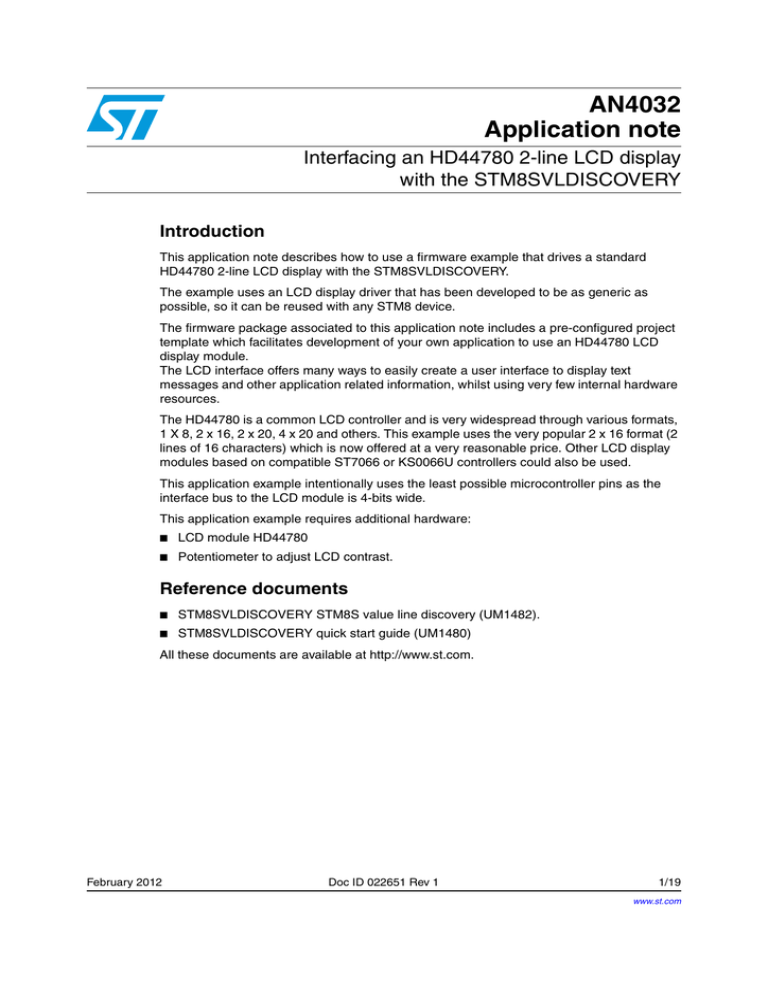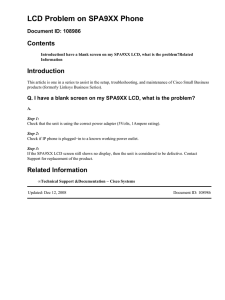
AN4032
Application note
Interfacing an HD44780 2-line LCD display
with the STM8SVLDISCOVERY
Introduction
This application note describes how to use a firmware example that drives a standard
HD44780 2-line LCD display with the STM8SVLDISCOVERY.
The example uses an LCD display driver that has been developed to be as generic as
possible, so it can be reused with any STM8 device.
The firmware package associated to this application note includes a pre-configured project
template which facilitates development of your own application to use an HD44780 LCD
display module.
The LCD interface offers many ways to easily create a user interface to display text
messages and other application related information, whilst using very few internal hardware
resources.
The HD44780 is a common LCD controller and is very widespread through various formats,
1 X 8, 2 x 16, 2 x 20, 4 x 20 and others. This example uses the very popular 2 x 16 format (2
lines of 16 characters) which is now offered at a very reasonable price. Other LCD display
modules based on compatible ST7066 or KS0066U controllers could also be used.
This application example intentionally uses the least possible microcontroller pins as the
interface bus to the LCD module is 4-bits wide.
This application example requires additional hardware:
■
LCD module HD44780
■
Potentiometer to adjust LCD contrast.
Reference documents
■
STM8SVLDISCOVERY STM8S value line discovery (UM1482).
■
STM8SVLDISCOVERY quick start guide (UM1480)
All these documents are available at http://www.st.com.
February 2012
Doc ID 022651 Rev 1
1/19
www.st.com
Contents
AN4032
Contents
1
2
Application description . . . . . . . . . . . . . . . . . . . . . . . . . . . . . . . . . . . . . . 5
1.1
Hardware required . . . . . . . . . . . . . . . . . . . . . . . . . . . . . . . . . . . . . . . . . . . 5
1.2
STM8SVLDISCOVERY hardware settings . . . . . . . . . . . . . . . . . . . . . . . . . 5
1.3
HD44780 LCD display module description . . . . . . . . . . . . . . . . . . . . . . . . . 5
1.4
Hardware interface application schematics . . . . . . . . . . . . . . . . . . . . . . . . 6
1.5
Application principle . . . . . . . . . . . . . . . . . . . . . . . . . . . . . . . . . . . . . . . . . . 8
1.5.1
Overview . . . . . . . . . . . . . . . . . . . . . . . . . . . . . . . . . . . . . . . . . . . . . . . . . 8
1.5.2
LCD interface . . . . . . . . . . . . . . . . . . . . . . . . . . . . . . . . . . . . . . . . . . . . . . 8
1.5.3
Custom characters definition . . . . . . . . . . . . . . . . . . . . . . . . . . . . . . . . . . 9
Software description . . . . . . . . . . . . . . . . . . . . . . . . . . . . . . . . . . . . . . . . 11
2.1
STM8S peripherals used by the application . . . . . . . . . . . . . . . . . . . . . . . 11
2.2
Configuring STM8S/A standard peripherals library . . . . . . . . . . . . . . . . . 12
2.3
2.2.1
For use with this application . . . . . . . . . . . . . . . . . . . . . . . . . . . . . . . . . . 12
2.2.2
For other uses of the HD44780 LCD display driver . . . . . . . . . . . . . . . . 12
Application software description . . . . . . . . . . . . . . . . . . . . . . . . . . . . . . . . 13
2.3.1
Main application flowchart . . . . . . . . . . . . . . . . . . . . . . . . . . . . . . . . . . . 13
2.3.2
HD44780 LCD display module library description . . . . . . . . . . . . . . . . . 15
3
Conclusion . . . . . . . . . . . . . . . . . . . . . . . . . . . . . . . . . . . . . . . . . . . . . . . . 17
4
Revision history . . . . . . . . . . . . . . . . . . . . . . . . . . . . . . . . . . . . . . . . . . . 18
2/19
Doc ID 022651 Rev 1
AN4032
List of tables
List of tables
Table 1.
Table 2.
Table 3.
LCD display module connector pin assignments . . . . . . . . . . . . . . . . . . . . . . . . . . . . . . . . . 6
HD44780.c functions relevant to LCD display . . . . . . . . . . . . . . . . . . . . . . . . . . . . . . . . . . 15
Document revision history . . . . . . . . . . . . . . . . . . . . . . . . . . . . . . . . . . . . . . . . . . . . . . . . . 18
Doc ID 022651 Rev 1
3/19
List of figures
AN4032
List of figures
Figure 1.
Figure 2.
Figure 3.
Figure 4.
Figure 5.
Figure 6.
4/19
HD44780 LCD display module . . . . . . . . . . . . . . . . . . . . . . . . . . . . . . . . . . . . . . . . . . . . . . 5
Hardware interface of the LCD display and the STM8SVLDISCOVERY . . . . . . . . . . . . . . . 7
HD44780 LCD display demonstration . . . . . . . . . . . . . . . . . . . . . . . . . . . . . . . . . . . . . . . . . 8
Example of A character definition . . . . . . . . . . . . . . . . . . . . . . . . . . . . . . . . . . . . . . . . . . . . 9
Custom characters of application example . . . . . . . . . . . . . . . . . . . . . . . . . . . . . . . . . . . . 10
Main application flowchart . . . . . . . . . . . . . . . . . . . . . . . . . . . . . . . . . . . . . . . . . . . . . . . . . 14
Doc ID 022651 Rev 1
AN4032
Application description
1
Application description
1.1
Hardware required
This application uses the STM8SVLDISCOVERY on-board LED LD1, an HD44780 or
equivalent 2-line LCD display and a 10 kΩ to 20 kΩ potentiometer to adjust LCD contrast.
Some LCD models include an LCD backlight feature but this application note does not deal
with this implementation. The LCD display module used in this example is a WINTEK WDC1602R which is fully compliant with an HD44780 controller, it has 16 characters X 2 lines
and a character format of 5 X 8 dots. The LCD current consumption for logic is typically
2 mA.
1.2
STM8SVLDISCOVERY hardware settings
JP1 (power supply jumper) must be put in the 5V position, to provide the correct VDD for
LCD module operation. There are no other specific settings for the STM8SVLDISCOVERY.
The LCD can be:
1.3
●
Connected directly with extra wires to the STM8SVLDISCOVERY CN1, CN2 and CN3
connectors.
●
Interfaced with a daughterboard (connected via these same connectors, plus CN4 for
mechanical support) that receives the LCD module and the potentiometer with a proper
PCB layout (not detailed here).
HD44780 LCD display module description
The LCD display module includes 2 16-character lines and a 16-pin connector. Each
character position is identified by its row number (1 or 2), and its column number (from 1 to
16). For example, when used in the software library: Location (2, 10) refers to the 10th
character of the 2nd line. See Table 1 on page 6 for connector details.
Figure 1.
HD44780 LCD display module
/&''LVSOD\SLQV
FKDUDFWHUV
/LQH
/LQH
-36
Doc ID 022651 Rev 1
5/19
Application description
Table 1.
1
0V
1.4
LCD display module connector pin assignments
2
GND VCC
AN4032
3
4
5
6
VEE
or V0
RS
R/W
E
7
8
9
10
11
12
13
14
15
16
DB0 DB1 DB2 DB3 DB4 DB5 DB6 DB7 NC NC
Register
LCD
Read/Write Enable
Select
4-bit low order data
+5V power
0: Write
LCD
bus
0: Command
supply
1: Read
module
1: Data
4-bit high order data
bus
-
-
Hardware interface application schematics
The LCD display module can easily be interfaced with the STM8SVLDISCOVERY using the
application schematics (Figure 2).
On the STM8SVLDISCOVERY side, the application uses 7 microcontroller I/Os, see the
proposed hardware configuration in Figure 2. When required, users can easily modify the
pin selection in the application software by editing the LCD port declarations in the
HD44780.h header file. The only considerations to take into account are the pins’
compatibility according to their function:
●
For example, PE5 supplies LCD drive current due to its high sink capability (can drive
more current than a standard port). If you change the MCU I/O which powers the LCD
module, you must ensure that it features high sink capability.
●
Some pins of the STM8S003K3 have no internal push-pull capability so they cannot be
selected for the LCD port, control or power pins. Please read the pins description in the
STM8S003K3 datasheet carefully if hardware configuration change is required.
On the LCD display side:
●
In order to display a character or send a command to the LCD, a byte corresponding to
the character ASCII code or to the command byte value must be sent. Data can be sent
from the MCU to the LCD in 4-bit or 8-bit operation.
–
In 8-bit mode, this operation is done in one send.
–
In 4-bit mode, this operation requires two sends of 4-bit data.
This application uses 4-bit operation, so only DB4 to DB7 need to be connected (LCD
4-bit data bus) and DB0 to DB3 are not connected.
If the LCD port is changed, the user must assign the lower nibble of a new MCU port to
the LCD data bus. For example, in this application example MCU port B is the LCD port
with PB0 to PB3 pins. If a different MCU port was chosen, the choice of possible LCD
port pins is limited to Px0 to Px3 (due to firmware management), where x can be A, B,
C, etc… according to the pins availability on the device.
●
The R/W pin of the LCD display module is connected to GND (Write is active).
Only Write operations to LCD memory are performed in this example. Data are
exclusively written into LCD and the firmware provides adequate timing needed for
each command without polling the internal LCD busy flag.
A potentiometer is connected to VEE/V0. Contrast can be adjusted accordingly.
6/19
Doc ID 022651 Rev 1
AN4032
Application description
Figure 2.
Hardware interface of the LCD display and the STM8SVLDISCOVERY
3
NWRN
*1'
&1*1'
9&&
&13(
9((
&13&
56
&13&
5:
&13%
(
&13%
'%1&
&13%
'%1&
&13%
'%1&
'%1&
'%
'%
'%
'%
67069/',6&29(5<
Note:
+'/LQH/&''LVSOD\
After power ON, the LCD display must be initialized once only. During a debug session, user
can be led to reset the MCU and then to force a second initialization while the LCD has not
been powered OFF. To prevent the LCD display from an unexpected initialization, the LCD
pin VCC is connected to the MCU pin PE5 to manage by software the LCD power. This
ensures that an LCD power OFF is performed before any LCD initialization attempt.
Once your code has been completely developed and debugged, it is possible to fix the LCD
pin VCC by connecting it permanently to the +5V power supply and by removing PE5 pin
management in software. This will free-up one more pin on the microcontroller side.
Doc ID 022651 Rev 1
7/19
Application description
AN4032
1.5
Application principle
1.5.1
Overview
This application note demonstrates some of the LCD functions provided in the library and
explains how they can be combined to create your own menus for the final application. Once
the hardware has been connected to the STM8SVLDISCOVERY and the software example
loaded in the STM8S device memory, a welcome message “STM8SVLDISCOVERY” is
displayed on the LCD screen. The user is then invited to press the on-board push-button to
continue the demonstration. This brief LCD demonstration simultaneously refreshes 4
changing items such as shown in Figure 3:
Figure 3.
●
an 8-character bar graph using custom characters defined in the LCD’s memory
●
a time counter that counts minutes, seconds and hundredths of seconds
●
the square value of an incrementing variable
●
a rolling text message that is updated every second
HD44780 LCD display demonstration
MS30017V1
This firmware example uses some of the basic functions available in the HD44780 driver
(initializing the LCD, printing characters strings to the LCD, using LCD display ON/OFF,
setting cursor position, clearing the LCD display, etc…).
Up to 8 user characters (5 x 8 dots each) can be managed to create special characters or
even limited graphics by combining them, as for instance, on a 4 x 2 characters matrix
displayed on 2 lines. Section 1.5.3 describes how to create your own characters.
1.5.2
LCD interface
This LCD interface allows users to control the HD44780 module to display text, messages or
other information related to the needs of the application. The LCD port 4-bit wide data bus is
8/19
Doc ID 022651 Rev 1
AN4032
Application description
managed by 4 lines connected to PB0 to PB3 microcontroller pins. In addition, there are 3
control pins RS, R/W and E.
1.5.3
●
R/W is set to write mode (0) as data is always sent from the microcontroller to the LCD
module and not in the opposite direction.
●
RS is the register select pin. This pin allows the LCD module to decide if data coming
from the microcontroller must be interpreted as an LCD command, or if it must be
treated as text data to be displayed on the LCD screen.
●
E enables LCD access for each MCU to LCD transaction. As soon as a communication
starts from the microcontroller side, this pin must be put high to enable the LCD. It
returns to low level once the procedure is completed.
Custom characters definition
This section describes how users can create their own custom characters.
Each custom character must be defined in the LCD display module CGRAM (Character
Generator RAM) of the HD44780 device.
●
For 5 X 8 pixel based LCD characters, up to 8 characters can be stored in the CGRAM.
●
A character is defined by 8 bytes (only 5 bits are considered, the others are not set)
representing the character pattern for each row.
●
A displayed dot is stored as 1 in the character bytes, otherwise it is 0.
●
These 8 bytes can be stored in a character table that will be transferred in the CGRAM
memory of the HD44780 controller.
Figure 4.
Example of A character definition
#HARACTER
D D D D D
XE
X
X
X
XF
X
X
X
-36
To define the application custom characters related to the bar graph used in our example,
we created the following 6 characters stored in a single tab.
Doc ID 022651 Rev 1
9/19
Application description
Figure 5.
AN4032
Custom characters of application example
&KDUDFWHU
&KDUDFWHU
&KDUDFWHU
&KDUDFWHU
&KDUDFWHU
&KDUDFWHU
-36
These characters are then written into the HD44780 LCD display module at the start
address of CGRAM @0x40. These characters are defined from number 0 to 5 and can be
called directly by printing their hexadecimal code.
For instance, the C instruction LCD_printstring(“\3\n”) displays Character 3 at the
current cursor position. Displaying the bar graph prints a string containing the characters’
numbers (progressively changing from Character 0 to Character 5) at the same LCD display
location.
10/19
Doc ID 022651 Rev 1
AN4032
Software description
2
Software description
2.1
STM8S peripherals used by the application
This application example uses the following STM8S peripherals and settings:
●
●
TIM4: generates a 1 ms time base, used for precise delays and other timing necessary
for LCD display and menu display management.
–
TIM4 input clock is set to 16 MHz, and the prescaler to 128 (f= 125 kHz)
–
TIM4 period is set to124 thus producing a time base of 1 ms.
GPIOs:
STM8SVLDISCOVERY standard resources:
–
Port C (PC4) set as input floating (push-button B1)
–
Port D (PD0) set as output push-pull (LED LD1)
HD44780 interface control resources: The LCD display module needs a port dedicated
to the data bus (4-bit wide), a port dedicated to LCD control (E, RS) and a port to
supply the LCD power (VCC pin):
–
Port B (PB0 to PB3) set as output push-pull is the LCDPort (data bus)(a)
–
Port C (PC1 and PC2) set as output push-pull is the LCDControlPort (RS and E
pins)(a)
–
Port E (PE5) set as output push-pull is the LCDPwrPort (VCC of LCD)(a)(b)
The MCU I/Os selected to drive the HD44780 interface are configured through
#define statements in the HD44780.h file as follows:
●
#define LCDPort GPIOB
LCD data bus assigned to PB
#define LCDControlPort GPIOC
LCD control pins E & RS assigned to PC
#define LCDPwrPort GPIOE
LCD power supply pin assigned to PE
#define LCDPwrPin GPIO_PIN_5
LCD power supply pin assigned to Px5
#define LCD_Enable GPIO_PIN_1
LCD enable pin assigned to Px1
#define LCD_RS GPIO_PIN_2
LCD RS pin assigned to Px2
CLK (clock control): HSI (high speed internal 16 MHz) is selected as the main clock
source. The SYSCLK prescaler is set to 1 so that CPU frequency is equal to 16 MHz.
a. If the user wants to use other pins than the proposed ones, they must be configurable as output push-pull.
b. If another power pin is used instead, it must have a high sink capability.
Doc ID 022651 Rev 1
11/19
Software description
AN4032
2.2
Configuring STM8S/A standard peripherals library
2.2.1
For use with this application
The stm8s_conf.h file of the STM8S/A standard peripherals library configures the library by
enabling the peripheral functions used by the application. The following define statements
must be present:
#include «stm8s_clk.h»
#include «stm8s_tim4.h»
#include «stm8s_gpio.h»
2.2.2
For other uses of the HD44780 LCD display driver
To reuse the HD44780 LCD display module files outside of this application project,
especially for any other STM8x family project, the following files should be imported in the
new project:
●
HD44780.c, HD44780.h, delay.c, delay.h.
●
TIM4 and GPIO libraries should also be imported unless other resources are selected:
–
As all delays are managed by the TIM4 peripheral, the TIM4 peripheral resource
or other available timer should also be included in the project and initialized with
the parameters of this application note example.
–
Similarly, ports of STM8x microcontroller must be managed with the GPIO
standard library of the selected device.
Please refer to the product datasheets to verify if the required peripherals or
resources are available on the microcontroller being used in the new project.
This application software includes a pre-configured project template in the \Projects folder of
the application note resources named HD44780_template.
This provides an easy starting point to develop an HD44780 LCD based application. It
includes HD44780 LCD display management and contains all the necessary software
resources to drive an LCD display module with the minimum starting configuration.
12/19
Doc ID 022651 Rev 1
AN4032
Software description
2.3
Application software description
2.3.1
Main application flowchart
The main application initializes the peripherals that are used in this LCD display module
demonstration in the following sequence:
1.
Configures CLK (clock control), GPIO and TIM4 peripherals.
2.
Enables the LCD power pin via the dedicated LCD power I/O (PE5 here).
3.
After LCD power ON, a 100 ms delay is respected to guarantee proper LCD operation.
4.
Initializes HD44780 LCD. Clears LCD screen.
5.
Loads custom characters into the CGRAM of the LCD display device.
6.
Displays welcome menu. Waits until B1 push-button is pressed to enter LCD demo.
7.
Once the LCD demo is entered, the application remains in this state until
STM8SVLDISCOVERY start-up.
a)
On the top left, an 8-character bar graph (Figure 3) is progressively filled then
cleared.
b)
On the top right, the square value of a variable varying from 0 to 128 is
permanently updated.
c)
On the bottom left, a time counter including minutes, seconds, tenths and
hundredths of seconds is refreshed. This time counter is updated every 1 ms
interrupt of TIM4. The total duration of this time counter is one hour maximum but
it can be reset at any time by pressing B1.
d)
On the bottom right, the 5 words STM8S, Value, Line, 8-Bit and Micro are
displayed successively at a rate of 1 word per second.
e)
The display is turned ON and OFF periodically.
There is no particular connection between these 4 displayed items.
This example demonstrates the performance of the STM8SVLDISCOVERY. It shows that
the LCD display module can be driven in different ways and that the STM8SVLDISCOVERY
has the capability to refresh different kinds of information at the same time.
Doc ID 022651 Rev 1
13/19
Software description
Figure 6.
AN4032
Main application flowchart
34!24
#LOCKCONFIGURATION
'0)/CONFIGURATION
4)-%NABLEMSINTERRUPT4IME
BASE
($,#$
0OWER/.
($ ,#$)NIT
($ ,#$#LEAR
DISPLAY
($ ,#$,OAD
#USTOM#HARACTERS
7ELCOME-ENU
.
"PRESSED
9
($,#$$EMO
-36
14/19
Doc ID 022651 Rev 1
AN4032
2.3.2
Software description
HD44780 LCD display module library description
The HD44780 LCD display module library includes 2 files: HD44780.c and HD44780.h.
These 2 files are associated with delay.c and delay.h for timings that are necessary for LCD
display management. As a reminder, all delays generated are linked to the TIM4 usage and
the recommended settings. Table 2 only describes the functions included in the HD44780.c
file that make available actions that can be performed with the LCD display.
Table 2.
HD44780.c functions relevant to LCD display
Function Name
Description
In Parameter(s)
Return
value
void LCD_LOAD_CGRAM
(char tab[], u8 charnum)
Load custom characters into HD44780
CGRAM. Preceding this function, an LCD
command instruction with CGRAM starting
address as argument must be sent
(LCD_CMD(address)).
char tab[]: table containing
custom characters data (8
bytes a character).
u8 charnum: number of
characters that will be loaded
void LCD_PWRON(void)
Set HIGH the LCD power pin assigned to
LCD VCC power line (LCD ON).
None
None
void LCD_PWROFF(void)
Set LOW the LCD power pin assigned to
LCD VCC power line (LCD OFF).
None
None
void LCD_ENABLE(void)
Set HIGH the LCD Enable pin assigned to
LCD E line for 2ms (then return to LOW).
None
None
void LCD_CMD
(unsigned char cmd_data)
Send command to LCD (instruction, no text
data).
unsigned char cmd_data:
command value
None
void LCD_INIT(void)
Initialize the LCD display module in 4-bit
mode. This function can only be called after
None
LCD power ON. Manages mandatory delays
between each command.
void LCD_printchar
(unsigned char ascode)
Print 1 character to LCD display module.
void LCD_printstring
(unsigned char *text)
Print one character string to the LCD display unsigned char *text:
module (string must end by \n terminal).
characters string ended by \n
None
void
LCD_CLEAR_DISPLAY
(void)
Clear LCD display and set cursor at home
position.
None
None
void LCD_2ndROW(void)
Set cursor to first column of 2nd row.
None
None
void LCD_HOME(void)
Set cursor to home position, first column of
1st row.
None
None
void LCD_LSHIFT(void)
Shift display left. All characters on screen
are shifted one position to the left.
None
None
void LCD_RSHIFT(void)
Shift display right. All characters on screen
are shifted one position to the right.
None
None
void LCD_DISP_ON(void)
LCD display is turned ON.
None
None
None
None
void LCD_DISP_OFF(void) LCD display is turned OFF.
Doc ID 022651 Rev 1
unsigned char ascode:
character code
None
None
15/19
Software description
Table 2.
AN4032
HD44780.c functions relevant to LCD display (continued)
Function Name
Description
In Parameter(s)
u8 row: ROW number (must
be between 1 to 2)
u8 column: COLUMN
number (must be included
between 1 to 16)
void LCD_LOCATE
(u8 row, u8 column)
Cursor is set at location defined by row and
column. Eg: LCD_LOCATE(1,4) sets cursor
on first line in 4th position. If position is out of
range, then no action. Physical address of
1st line is 0x00; 2nd line is 0x40
void LCD_printf
(const char *fmt, ...)
Print characters strings with specified format
const char *fmt, ...:
(does not support all formats depending
characters string with
on compiler limitations). Needs to include
specified format
stdarg.h library in header file.
16/19
Doc ID 022651 Rev 1
Return
value
None
None
AN4032
3
Conclusion
Conclusion
LCD character display modules are very common in many 8-bit microcontroller based
applications. With a very affordable price and a quick implementation time, they offer the
easiest way to realize a simple and efficient interface for various applications in industry,
consumer, metering, telecommunications and other domains.
This short example includes all the basic functions to drive an HD44780 LCD controller and
any other compatible LCD display modules. This brief demo provides
STM8SVLDISCOVERY users with many possibilities to quickly create interfaces and
menus.
This application note can also be tailored for any microcontroller of the STM8 family with
slight firmware modifications.
Doc ID 022651 Rev 1
17/19
Revision history
4
AN4032
Revision history
Table 3.
18/19
Document revision history
Date
Revision
16-Feb-2012
1
Changes
Initial release.
Doc ID 022651 Rev 1
AN4032
Please Read Carefully:
Information in this document is provided solely in connection with ST products. STMicroelectronics NV and its subsidiaries (“ST”) reserve the
right to make changes, corrections, modifications or improvements, to this document, and the products and services described herein at any
time, without notice.
All ST products are sold pursuant to ST’s terms and conditions of sale.
Purchasers are solely responsible for the choice, selection and use of the ST products and services described herein, and ST assumes no
liability whatsoever relating to the choice, selection or use of the ST products and services described herein.
No license, express or implied, by estoppel or otherwise, to any intellectual property rights is granted under this document. If any part of this
document refers to any third party products or services it shall not be deemed a license grant by ST for the use of such third party products
or services, or any intellectual property contained therein or considered as a warranty covering the use in any manner whatsoever of such
third party products or services or any intellectual property contained therein.
UNLESS OTHERWISE SET FORTH IN ST’S TERMS AND CONDITIONS OF SALE ST DISCLAIMS ANY EXPRESS OR IMPLIED
WARRANTY WITH RESPECT TO THE USE AND/OR SALE OF ST PRODUCTS INCLUDING WITHOUT LIMITATION IMPLIED
WARRANTIES OF MERCHANTABILITY, FITNESS FOR A PARTICULAR PURPOSE (AND THEIR EQUIVALENTS UNDER THE LAWS
OF ANY JURISDICTION), OR INFRINGEMENT OF ANY PATENT, COPYRIGHT OR OTHER INTELLECTUAL PROPERTY RIGHT.
UNLESS EXPRESSLY APPROVED IN WRITING BY TWO AUTHORIZED ST REPRESENTATIVES, ST PRODUCTS ARE NOT
RECOMMENDED, AUTHORIZED OR WARRANTED FOR USE IN MILITARY, AIR CRAFT, SPACE, LIFE SAVING, OR LIFE SUSTAINING
APPLICATIONS, NOR IN PRODUCTS OR SYSTEMS WHERE FAILURE OR MALFUNCTION MAY RESULT IN PERSONAL INJURY,
DEATH, OR SEVERE PROPERTY OR ENVIRONMENTAL DAMAGE. ST PRODUCTS WHICH ARE NOT SPECIFIED AS "AUTOMOTIVE
GRADE" MAY ONLY BE USED IN AUTOMOTIVE APPLICATIONS AT USER’S OWN RISK.
Resale of ST products with provisions different from the statements and/or technical features set forth in this document shall immediately void
any warranty granted by ST for the ST product or service described herein and shall not create or extend in any manner whatsoever, any
liability of ST.
ST and the ST logo are trademarks or registered trademarks of ST in various countries.
Information in this document supersedes and replaces all information previously supplied.
The ST logo is a registered trademark of STMicroelectronics. All other names are the property of their respective owners.
© 2012 STMicroelectronics - All rights reserved
STMicroelectronics group of companies
Australia - Belgium - Brazil - Canada - China - Czech Republic - Finland - France - Germany - Hong Kong - India - Israel - Italy - Japan Malaysia - Malta - Morocco - Philippines - Singapore - Spain - Sweden - Switzerland - United Kingdom - United States of America
www.st.com
Doc ID 022651 Rev 1
19/19







